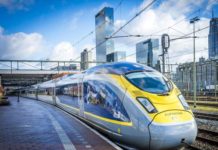Plans for gleaming railway stations plaster the walls of the “map room” at Mexico’s National Fund for Tourism Development (Fonatur) — grand central for the “Maya Train”. This is one of Andrés Manuel López Obrador’s signature projects to kick-start the economy of the poor south-east. The tourist, passenger and cargo railway around the Yucatán peninsula would be 90 per cent funded by the private sector, the president promised. But after receiving insufficient interest from major infrastructure investors for proposed public-private partnerships, those plans have been ditched. Despite a cratering economy, the $7.4bn project will now be 100 per cent government-funded. “Major infrastructure firms looked at it with significant question marks over whether revenues would be realisable,” said Edmundo Gamas, executive director of the Mexican Institute of Infrastructure Development.
“It was definitely a vote of no confidence in the project and its financial viability.” Grand public works projects that can crown a president’s six-year term have long been the norm in Mexico. But Mr López Obrador is more ambitious than most. He plans to build an $8bn refinery, a $4.2bn airport and a $170m Trans-Isthmus transport corridor, as well as 2,700 branches of a state development bank costing $530m — all in addition to the Maya Train. For Mr López Obrador, these are not just priority infrastructure but urgent social projects aimed at lifting up under-developed parts of Mexico.
The problem is that with state finances under pressure after the economy contracted 0.1 per cent last year, analysts and even some government insiders fear that Mr López Obrador’s dreams will be hard to deliver. “They could end up as white elephants,” said Guadalupe Correa-Cabrera, an associate professor at George Mason University.“I don’t have a problem with the state guiding the economy but I am very concerned that I still don’t see a plan or the capacity of the state to pull off these investments.” One senior official agreed that they risked falling short of expectations — “if they get finished, that is”.
Rogelio Jiménez Pons, Fonatur chief, said studies had shown that the hybrid diesel-electric Maya Train, which is scheduled to start test operations in 2023, would be “highly profitable”, a claim treated with scepticism by business groups. Mr Jiménez Pons said the train, which will revamp existing track along part of its route, would bring orderly urban development, environmental protection and welfare for marginalised communities. “It’s a different vision of development — don’t prejudge us.” The project faces litigation from local landowners and from environmentalists who say it risks destroying jungles. Mr López Obrador is pushing ahead with his other infrastructure projects, too, in spite of similar doubts about their feasibility.
The Dos Bocas refinery in the president’s native Tabasco is perhaps the one dearest to his heart. Despite cheap and plentiful renewable energy, the president has emphasised fossil fuels and sees the refinery as a way for Mexico to sever its dependence on imported US fuel and revitalise struggling state oil company, Pemex. He is powering ahead with the project on reclaimed swamp land even though experts say its budget and timeframe — it is due to be finished in mid-2022 — are unrealistic. Then there is the new airport. Before taking office, Mr López Obrador scrapped a one-third built, $13bn Norman Foster-designed airport, saying it was wasteful and plagued with corruption.
He has put the army to work on building a more modest one on a military base that he says will be inaugurated on March 21 2022 “or my name is not Andrés Manuel”. However, there are lingering fears that operating the new airport in tandem with the existing Mexico City airport may not be technically feasible. And history offers a cautionary tale for the Trans-Isthmus railway. The train across the Isthmus of Tehuantepec — a short-cut between the Atlantic and the Pacific that Mr López Obrador sees as an alternative to the Panama Canal for some freight — revives a more than century-old project that “never really got past the white elephant reputation”, according to Andrew Paxman, a historian and professor at Mexico’s CIDE university.
The original route, begun in the 1840s and not finished for half a century, was “practically useless” upon completion because its track was not standard and the ports were inadequate, said Mr Paxman. It had to be revamped and was reinaugurated in 1907 but “only worked as the route of choice for seven years because, in 1914, the Panama Canal was opened”. Mr López Obrador’s drive to boost regions of the country long left behind has been widely welcomed as just and long overdue.
“But microcredits could have had a much bigger social effect,” said Xavier Ginebra Serrabou, a trade lawyer and columnist. Sceptics point to political considerations, and not just the desire to help poor regions. Duncan Wood, head of the Mexico Institute at the Wilson Center, a think-tank, said the 2,700 branches of the state-run Welfare Bank that the president says the army will build within two years were intended to remind recipients of government social programmes and handouts that they owed their improved income to the president. “It’s doing an economic project because it is politically important,” he said. Mr Gamas said of the Maya Train: “It’s hard to understand why, per peso spent, we wouldn’t want to use the money to build hospitals. “We could, and probably will, have a white elephant. The only question is whether it’s a baby or a fully-grown male with big tusks.”






















